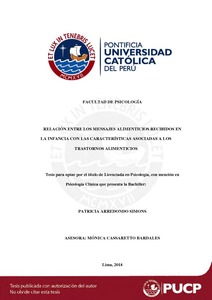| dc.contributor.advisor | Cassaretto Bardales, Mónica de los Milagros | es_ES |
| dc.contributor.author | Arredondo Simons, Patricia | es_ES |
| dc.date.accessioned | 2018-03-26T16:07:10Z | es_ES |
| dc.date.available | 2018-03-26T16:07:10Z | es_ES |
| dc.date.created | 2018 | es_ES |
| dc.date.issued | 2018-03-26 | es_ES |
| dc.identifier.uri | http://hdl.handle.net/20.500.12404/11722 | |
| dc.description.abstract | El objetivo general de la presente investigación fue analizar la relación entre los mensajes
alimenticios trasmitidos por los cuidadores durante la infancia y la presencia de
características tanto psicológicas como comportamentales asociadas al riesgo de
desarrollar trastornos alimenticios. El universo de estudio fue conformado por 121
mujeres escolares entre los 13 y 18 años de edad (M=15.43, DE=1.08) que cursan de
tercero a quinto grado de secundaria de un colegio particular de Lima. Se empleó el
Inventario de Trastornos de la Conducta Alimentaria EDI-2 (Garner, 1998), así como el
Caregiver Eating Messages Scale (CEMS), instrumento diseñado por Kroon Van Diest
& Tylka en el 2010. Los resultados evidencian la existencia de asociaciones significativas
entre las dos dimensiones del CEMS (mensajes de obligatoriedad y restricción) y las
características asociadas al riesgo de desarrollar trastornos alimenticios. Las correlaciones
más altas se dieron entre la dimensión de restricción con las escalas de insatisfacción
corporal (r=46) e impulsividad (r= 46). Mientras que la dimensión de obligatoriedad se
relacionó con obsesión por la delgadez (r=30) y perfeccionismo (r=32). Respecto a la
escala de miedo a la madurez, se encontró que correlacionaba positivamente con
obligatoriedad y negativamente con restricción. Además, se encontraron diferencias a
partir de las variables sociodemográficas como el grado, tipo de familia y el IMC
reportado. | es_ES |
| dc.description.abstract | The objective of the investigation was to examine the relationship between food messages
transmitted by caregivers during childhood and the presence of both psychological and
behavioral characteristics associated with the risk of developing eating disorders. The
study was made up of 121 school age females between 13 and 18 years of age (M = 15.43,
SD = 1.08) who attended a private school in Lima from third to fifth grade. The Food
Behavior Disorders Inventory EDI-2 (Garner, 1998) was used as well as the Caregiver
Eating Messages Scale (CEMS), an instrument designed by Kroon Van Diest & Tylka in
2010. The results show the existence of significant associations between the two
dimensions of CEMS (obligatory and restrictive messages) and characteristics associated
with the risk of developing eating disorders. The highest correlations were between the
restriction dimension with the scales of body dissatisfaction (r = 46) and impulsivity (r =
46). While the obligatory dimension was related to obsession with thinness (r = 30) and
low perfectionism (r = 38). Regarding the scale of fear of maturity, we found that it
correlated positively with obligatoriness and negatively with restriction. In addition,
differences were found based on sociodemographic variables such as grade, family type
and BMI reported. | es_ES |
| dc.language.iso | spa | es_ES |
| dc.publisher | Pontificia Universidad Católica del Perú | es_ES |
| dc.rights | Atribución-CompartirIgual 2.5 Perú | * |
| dc.rights | info:eu-repo/semantics/openAccess | es_ES |
| dc.rights.uri | http://creativecommons.org/licenses/by-sa/2.5/pe/ | * |
| dc.subject | Trastornos de la nutrición--Adolescentes | es_ES |
| dc.subject | Adolescencia | es_ES |
| dc.title | Relación entre los mensajes alimenticios recibidos en la infancia con las características asociadas a los trastornos alimenticios | es_ES |
| dc.type | info:eu-repo/semantics/bachelorThesis | es_ES |
| thesis.degree.name | Licenciado en Psicología con mención en Psicología Clínica | es_ES |
| thesis.degree.level | Título Profesional | es_ES |
| thesis.degree.grantor | Pontificia Universidad Católica del Perú. Facultad de Psicología | es_ES |
| thesis.degree.discipline | Psicología con mención en Psicología Clínica | es_ES |
| renati.advisor.dni | 09491245 | |
| renati.advisor.orcid | https://orcid.org/0000-0002-4880-6092 | es_ES |
| renati.discipline | 313026 | es_ES |
| renati.level | https://purl.org/pe-repo/renati/level#tituloProfesional | es_ES |
| renati.type | http://purl.org/pe-repo/renati/type#tesis | es_ES |
| dc.publisher.country | PE | es_ES |
| dc.subject.ocde | https://purl.org/pe-repo/ocde/ford#5.01.00 | es_ES |






